Trotton, W Sussex (†Chichester) C.14
The Seven Works of Mercy, with Judgement details & Moses
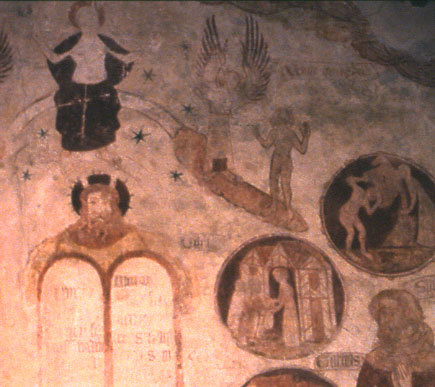
Very few paintings survive on the west walls of English churches, although all would have had some kind of decoration once. On the west wall at Trotton this rare example of a narrative subject was discovered in 1902, and it is almost intact. The scene combines Judgement details with morality subjects in a manner broadly similar to the complicated example at Beckley.

In the centre of the wall and shown at the right is Christ in judgement, the subject abbreviated and reduced to its essentials. Beside Christ and his double rainbow, an angel welcomes a newly arrived soul into heaven with the words ‘Venite benedicte’, inscribed on a scroll (left below) above the human soul’s head. The two figures stand on a kind of cloud-promontory, and directly below the judging Christ is Moses, wearing the customary horns as he once did at Friskney, where their significance is briefly discussed (in a footnote). An inscription on a scroll beside his left shoulder is unreadable now.
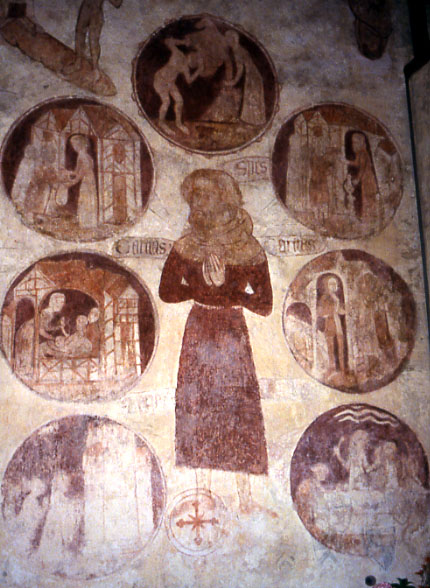
On the left (south) of Moses are the Seven Deadly Sins, described and pictured on a separate page. The Works of Mercy are in the corresponding position on the right (north), and these are shown below at the left. The central figure is a bearded man, wearing a long robe with a cowl, shown in an attitude of prayer, and surrounded by roundels with narrative scenes. Three scrolls around his head and shoulders are inscribed with the cardinal virtues Spes (Hope) and Caritas (Charity). Caritas appears twice, at shoulder level on either side, and Spes too was in all probability repeated in the same way (there is a hint of another scroll at head level matching the visible one on the opposite side). Fides (Faith) was almost certainly inscribed on the two faint scrolls beside the skirt of the figure about halfway down it.
The figure can safely be taken to represent Mercy, or the embodiment of ‘Good Deeds’, personified here as in medieval plays such as Everyman. Other paintings of this subject have a figure, not always centrally placed, performing much the same function – in the case of Potter Heigham a woman, at Barnby and Wickhampton Christ himself. All three are linked in the table below.
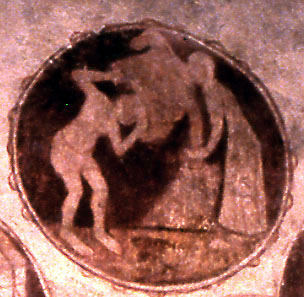
Three of the clearer individual scenes in the roundels are shown in detail. At the right is Clothing the Naked (above the central figure’s head), with a woman helping a man in a loincloth into a robe. Beside the central figure’s head at the left, and shown below left here, is Feeding the Hungry, featuring a particularly ambitious multi-gabled and timbered building, where the attempt to create convincing three-dimensional perspective is very evident.
A woman stands in the arched doorway, holding out a bag of some kind and what might be a ring-shaped loaf as at Pickering to two figures at the left.
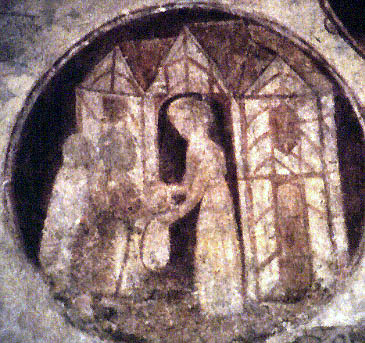
In the corresponding position at the right of the main figure is Giving Drink to the Thirsty, similarly organised, with a woman holding an ewer.
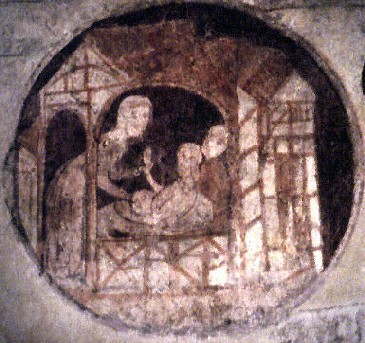
At the centre left of the principal figure, and shown here at the right, is another of the clearer scenes, Tending the Sick, where a woman bends over a man in bed, holding his right wrist, while another figure stands at the head of the bed in what might be an imploring attitude. Again, the architecture of the surrounding building is dauntingly complicated – like his counterpart at Moulton St Mary, this painter seems to have deliberately embraced all the difficulties of ‘naturalistic’ treatment.
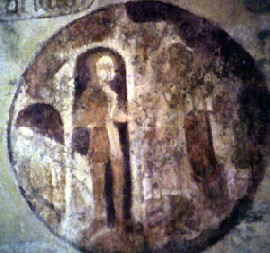
Opposite this is Receiving the Stranger (right), rather unclear but showing a man in a bi-coloured garment welcoming two people. Inside the house is what Tristram thought was either a bed, or a table spread with a cloth – on the wall, faint traces of circular dishes are just visible, so the latter seems to me most likely.
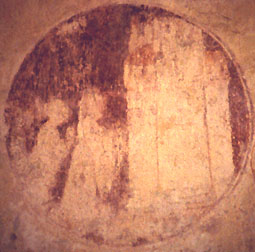
The lowest roundel at the left (left) is the least clear of all, but it is unusual for its treatment of Visiting the Prisoner. Instead of the much commoner village stocks or town jail of the other examples of this subject on the site, this prison is a forbidding, castle-like edifice, shown at the right of the scene, with a small group of people – Tristram¹ identified them as men, and remarked on their houpplandes, enveloping garments with very wide sleeves – approaching it. He could also see a figure looking out of a window in the building, but this is no longer visible.
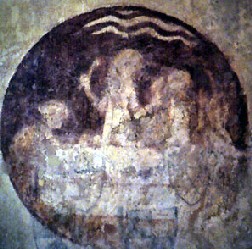
Finally comes Burying the Dead, rather obscure, but identifiable (right). A figure, probably a priest, stands centrally, asperging a rectangular coffin. Another figure, female according to Tristram, stands in a stooping posture at its foot, and there is at least one other person beside the asperging figure. At the far right is something else; it does not much resemble a human figure, and is, conceivably, a devil or personification of sin leaving the deceased at the asperging. This is no more than conjecture though – the detail is unclear even at very close quarters. Centrally placed at the top of the scene are some wavy lines, almost certainly representing Heaven, the dead soul’s destination. Several heraldic shields are also faintly visible; they seem to have been superimposed at a later date, and probably represent the Camoys family referred to below.
From the later thirteenth to the early fifteenth century Trotton church had strong associations with the Camoys family, some members of which are themselves painted elsewhere on the walls. These paintings will be on the site soon. Since Tristram dated the subjects on the west wall at around 1380, the money to pay for them might have come from the bequest of a Lady Camoys who died in 1386 and left 30 sheep to the church.
(Click the link for the Seven Deady Sins at Trotton)
Website for St George’s, Trotton
¹ Tristram III, p.260
† in page heading = Diocese